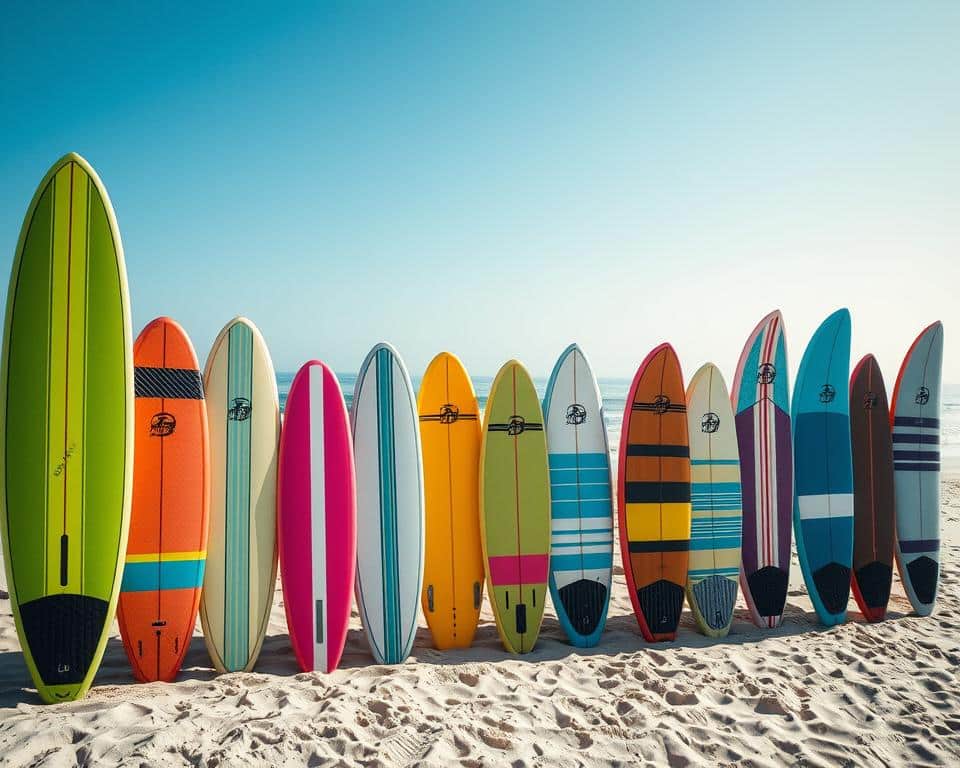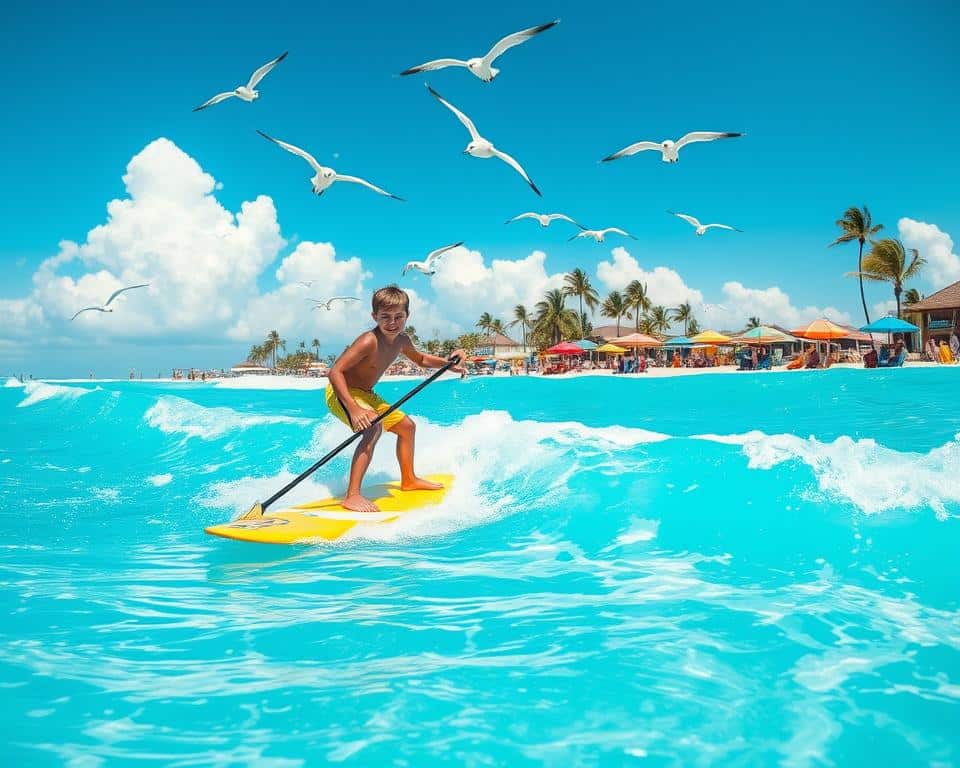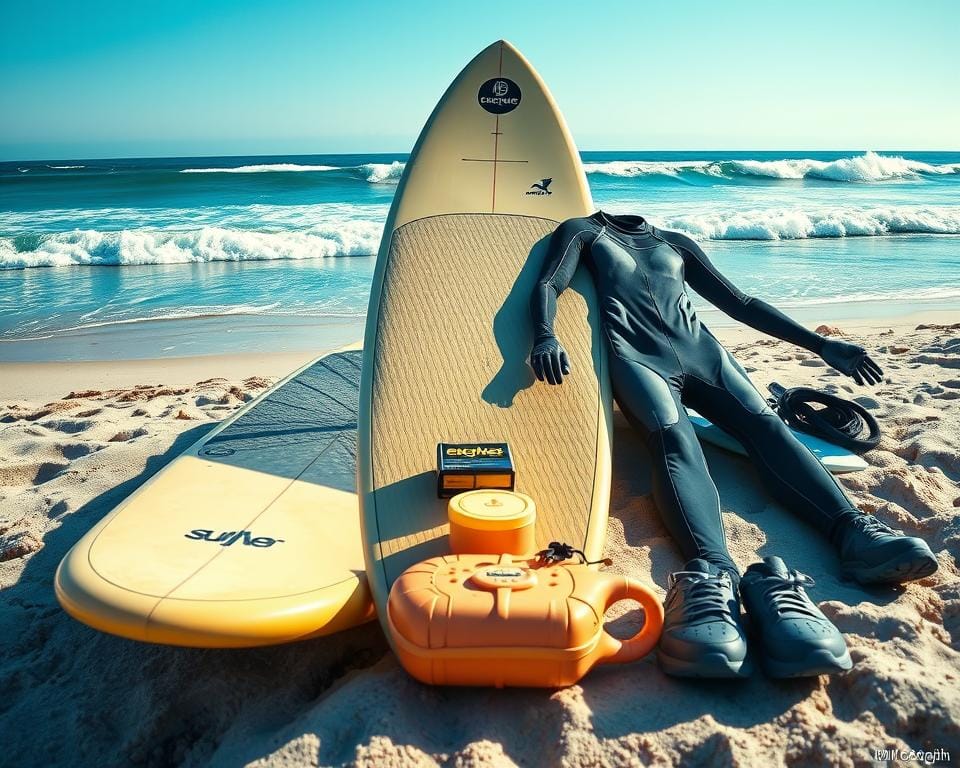Beginning your surfing adventure is both thrilling and demanding. It’s crucial to learn to surf under expert guidance. This ensures you properly understand the sea and its waves. To be good at surfing, you need to balance well on a board, know the ocean, and predict waves. I’ll share important tips to help you focus on the basics.
One key step for new surfers is to take lessons from a knowledgeable instructor. These lessons teach safety rules, how to catch waves, and essential surfing techniques. Learning the right surf manners helps you learn faster. It makes your surfing experience enjoyable and prevents problems with other surfers.
Also, think about joining custom luxury surf trips that match your surfing level. These trips offer expert advice and the enjoyment of a top-notch surf holiday. They can quicken your improvement in surfing.
To get good at surfing, practice regularly and keep trying. It’s important to practice moving quickly from lying down to standing on the board, even when on land. Remember, all expert surfers began as beginners. They learned to recognize waves and master the art of paddling.
Choosing the Right Surfboard for Beginners
Choosing the right surfboard is key for new surfers. The right board makes learning and fun go hand in hand. It boosts your confidence and skills in the waves.
Foam Boards vs. Hard Boards
Foam surfboards have lots of benefits for beginners. Brands like Catch Surf and Wavestorm make these foamies. They’re forgiving, stable, and safe, making falls less scary. Hard boards are tough and float well. Beginners like epoxy boards for these reasons. Yet, more experienced surfers often go for polyurethane boards for their flexibility.

Length and Size Recommendations
Getting the right surfboard size is important. Longboards, over 8 feet, are the easiest for beginners. They help with balance and catching waves. A board between 8’6” and 9’0” is good for someone 5’8″ to 6’0″ tall. But, stay away from shortboards early on. They’re tricky to balance and paddle. Mini Mal surfboards are good too. They give a nice mix of stability and ease for learners.
The Importance of a Leash
A surfboard leash is a must for safety. It keeps the board close if you fall. So, it won’t hit others. Plus, it saves you from retrieving your board too often. Brands like Channel Islands Surfboards and South Bay Board Co. stress a good leash’s value.
Learning about boards and leashes will improve your surf. The right gear, like a foam board or longboard with a leash, helps a lot. For more on surfboards, check here.
Surfing for Beginners: Basic Gear and Preparation
Before you start surfing, it’s critical to get the right surfing gear for beginners. The correct gear improves performance and ensures you’re safe and comfortable in the water.
Essential Gear Checklist
The three main items every beginner needs are:
- Surfboard: An 8 to 9 feet long foam board is perfect for beginners. It’s stable and easy to paddle. NSP’s P2 Soft Longboards are a great choice with their EcoBoard Level One verification.
- Surfboard Leash: Your leash should be one foot longer than your board for safety. Wave Tribe’s eco leashes are made from recycled plastics, making them a sustainable choice.
 A suitable wetsuit keeps you comfortable and warm, depending on the water temperature. Look for brands like Sensi Graves Swim, which use Repreve recycled plastics.
A suitable wetsuit keeps you comfortable and warm, depending on the water temperature. Look for brands like Sensi Graves Swim, which use Repreve recycled plastics.
Choosing the Right Wetsuit
For finding the best wetsuit, a detailed surf wetsuit guide can be very helpful. A 4/3mm wetsuit is needed for cold waters, but board shorts or a rash guard are okay for warmer conditions. Consider eco-friendly products like Matunas surf wax and All Good mineral sunscreen for environmental safety.
Practicing the Pop-Up on Land
Mastering the pop-up is key when practicing surfing on land. It’s the move that gets you from lying on your board to standing upright. Regular practice on land builds muscle memory. This makes the move easier to do in the water.
Getting used to the pop-up increases your confidence and betters your surfing skills. Knowing how to use your gear, from the surfboard to the surfboard leash, helps you become a good surfer. Enjoy your surfing journey!
Finding the Perfect Surf Spot
Finding the right surf spot is key for beginners who want to enjoy surfing. It’s important to pick a place that matches your skill level. Let’s look at some key features and tools to help you find great surf spots for beginners.
Characteristics of Beginner-Friendly Waves
Beginners should look for spots with beach break waves. These waves break over sandy bottoms and are safer for new surfers. Aim for waves that are 1 to 3 feet tall. They’re easy to handle but still give you a good ride.
La Jolla Shores in San Diego is famous for being great for beginners, especially in summer.
Importance of Minimal Crowds and Safety
It’s better to surf where it’s not crowded, especially if you’re just starting. This gives you space to practice. Places like Cowell Beach in Santa Cruz and Rockaway Beach in New York City can be good. But they’re less crowded in the early morning or on weekdays. Also, pick beaches with lifeguards, like Dana Point’s Doheny Beach, to stay safe.
Using Surf Apps to Check Conditions
Knowing the surf conditions is crucial for a safe surf session. Surf apps like Surfline can tell you about wave sizes and wind direction. They help you choose the best time and place to surf. This is especially helpful for beginners wanting to improve their skills in ideal conditions.
| Surf Spot | Location | Recommended Wave Size | Special Features |
|---|---|---|---|
| La Jolla Shores | San Diego, CA | 1-3 feet | Renowned for beginner-friendly conditions, lifeguard presence |
| Cowell Beach | Santa Cruz, CA | 1-3 feet | Historical beginner spot, minimal crowds in early mornings |
| Doheny Beach | Dana Point, CA | 1-3 feet | Slow, easy-breaking waves, lifeguard presence |
| Rockaway Beach | New York, NY | 1-3 feet | Vibrant surf culture, accessible via public transport |
Understanding Surf Etiquette and Safety
Every beginner in the waves must grasp surf etiquette. This set of rules keeps everyone safe and respected. At its core is the surfing right of way, which helps avoid collisions by showing who has wave priority.
One big rule is not to “drop in” on someone else’s wave. This mistake can cause conflicts and dangers. Always look for other surfers before you take a wave. This makes sure all can enjoy surfing safely. Signaling your intentions helps reduce tension and avoids mix-ups.
Knowing how to paddle correctly, like doing a duck dive or turtle roll, is crucial. These skills help you move under waves without losing control. It’s also vital to pick the right equipment, like a proper board and wetsuit for the temperature.
Beginners should watch how seasoned surfers behave and where they position themselves. This helps you learn wave manners. Being a good sport creates a friendly space and prevents bumps. Try to surf in less crowded areas to lower accident risks and improve your experience.
Being in good shape is essential for surf safety. Work on your swimming, push-ups, and planks to boost your strength and balance. Don’t forget to wax your board for better grip. Following these safety tips and etiquette makes surfing safe and fun for all.
Conclusion
Starting to surf is both exciting and challenging. It pushes your body and mind to new limits. Every step, from picking the right board to learning the rules, boosts your confidence in the water. Knowing how waves work and watching experienced surfers help a lot too. It’s also important to be patient as you learn.
Choosing the right board, like a longboard or softboard, makes learning easier. Surfing often helps your muscles remember what to do. Adding exercises like swimming and weight training can make you a better surfer.
Meeting other surfers can make your surfing journey more enjoyable. They offer support and share their experiences. Following surfing rules keeps everyone safe and shows respect to other surfers. Every fall and victory is part of becoming great at surfing. Enjoy every moment of riding the ocean waves.


 A suitable wetsuit keeps you comfortable and warm, depending on the water temperature. Look for brands like Sensi Graves Swim, which use Repreve recycled plastics.
A suitable wetsuit keeps you comfortable and warm, depending on the water temperature. Look for brands like Sensi Graves Swim, which use Repreve recycled plastics.